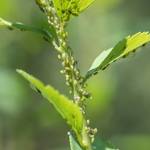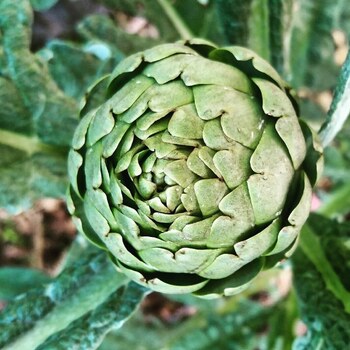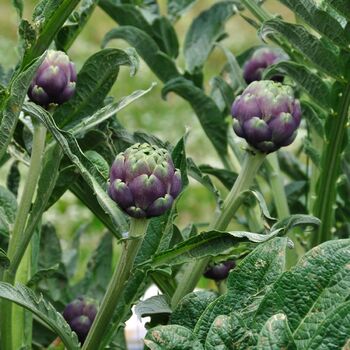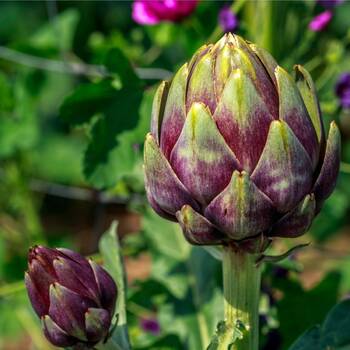
How to Grow Artichoke Seeds
Grow Guide #2227
Family: Asteraceae
Binomial name: Cynara scolymus
Life Cycle: Perennial
This 'How to Grow' guide details everything a home gardener needs to know to plant, grow and care for Artichokes (Cynara scolymus).
When to Sow Artichoke Seeds
Artichoke is a perennial plant that grows year round in most climates. Use the table below to identify the best time of year to sow artichoke seeds in your climate.
| JAN | FEB | MAR | APR | MAY | JUN | JUL | AUG | SEP | OCT | NOV | DEC | |
|---|---|---|---|---|---|---|---|---|---|---|---|---|
| Cool | ||||||||||||
| Temperate | ||||||||||||
| Sub-Tropical | ||||||||||||
| Tropical | ||||||||||||
| Arid |
Preparation
Artichoke plants can be grown as annuals or perennials. If growing as perennials, choose a permanent position where plants can grow undisturbed by regular digging or disturbance.
Artichoke plants are best grown in full sun. Choose a location that will receive at least 6 hours of full sun each day.
Artichoke plants need a well drained soil enriched with plenty of organic matter. Prepare soil by weeding it thoroughly, digging it over to loosen it and adding aged animal manure or compost. Keep the area free of weeds until planting. Learn more about preparing soil for planting here.
How to Sow Artichoke Seeds
Artichoke seeds do not require any treatment (eg soaking, stratification) before sowing.
Artichoke seeds can be sown directly into the garden OR seedlings can be raised in trays or other containers and transplanted to the garden once established.
Sow Direct
- Sow seeds directly in the garden 10mm deep and 50cm apart, with rows 50-80cm apart.
- Keep soil moist but never wet or dry.
- Seeds should germinate in around 5-20 days at a soil temperature of 21-26°C.
- Young seedlings will need protection from pests, pets and weather until they are established.
Raise Seedlings
- Fill trays, punnets or jiffy pots with a good quality seed-raising mix, or use soil starter pellets.
- Sow seeds 10mm deep.
- Keep soil moist but never wet or dry.
- Seeds should germinate in around 5-20 days at a soil temperature of 21-26°C.
- Transplant seedlings to the garden once they have their first true leaves and are large enough to handle (usually 5-10cm tall).
- Plant out, spacing plants 50cm apart, with rows 50-80cm apart.
Optional: In cool climates artichoke seeds can be sown indoors 6 weeks before the last expected frost. Grow them in a warm position with plenty of natural light.
How to Grow Artichoke
Artichoke plants may need watering during the growing season. Water when the soil is dry about 5cm below the surface (test this by scratching away a little soil with your finger). Water deeply in the early morning or late afternoon. Avoid watering the leaves of plants to avoid fungal diseases. Learn more about watering here.
If soil was well prepared no extra fertiliser should be necessary. In poor soil or to give your plants an extra boost, application of a balanced fertiliser or one formulated for fruit and vegetables can be beneficial:
- Apply slow release fertiliser at the recommended rate when transplanting or when seedlings are 5-10cm tall.
- Apply liquid fertiliser at the recommended rate and frequency while plants are fruiting or flowering.
Artichoke plants may need to be staked for support as they grow. Use a sturdy stake and tie stems gently to it using twine or plant ties.
If growing artichokes as perennials, cut plants to ground level after harvesting or when the leaves begin to yellow in autumn. Apply a thick layer of organic mulch around the stems.
How to Harvest Artichokes
Artichokes should be ready to harvest in approximately 290-400 days.
The globe-shaped flower buds (also sometimes called 'heads') are the part of the plant that is harvested. The entire flower bud is harvested but only the tender center of the bud (called the 'heart') is eaten.
The flower buds are ready to harvest when they reach full size and the bracts (the outer leaves surrounding the bud) just begin to open. Cut the buds from the stem using snips/secateurs, leaving 5cm of stem attached to the bud.
Eat artichoke as soon as possible after harvesting. Store buds short term in a perforated plastic bag in the fridge. For longer term storage, whole buds or hearts can be blanched in acidulated water and frozen or hearts can be pickled or preserved in oil.
Common Problems when Growing Artichokes
Like all plants, artichoke is susceptible to some pests, diseases and other problems. Below is a list of the most common problems gardeners encounter when growing artichoke plants:
 Aphids are small (2-4mm long) sap-sucking insects that congregate on the new shoots or the undersides of leaves. They can cause leaves to wilt or become discoloured, and also excrete honeydew which can attract ants and other insect pests. To manage aphids, remove them by spraying with a garden hose, apply a soap or alcohol spray, or encourage predatory insects to your garden. Read more about aphids here.
Aphids are small (2-4mm long) sap-sucking insects that congregate on the new shoots or the undersides of leaves. They can cause leaves to wilt or become discoloured, and also excrete honeydew which can attract ants and other insect pests. To manage aphids, remove them by spraying with a garden hose, apply a soap or alcohol spray, or encourage predatory insects to your garden. Read more about aphids here..jpg) Powdery mildew is caused by fungal spores reproducing on the leaves of plants. First showing as white spots on leaves, affected areas can spread quickly to cover the entire leaf surface. While rarely fatal, powdery mildew can reduce yields. Water plants at soil level (not on leaves) to prevent spreading spores, allow good air flow between plants, remove affected leaves and if necessary spray with an appropriate fungicide or homemade spray. Read more here about powdery mildew here.
Powdery mildew is caused by fungal spores reproducing on the leaves of plants. First showing as white spots on leaves, affected areas can spread quickly to cover the entire leaf surface. While rarely fatal, powdery mildew can reduce yields. Water plants at soil level (not on leaves) to prevent spreading spores, allow good air flow between plants, remove affected leaves and if necessary spray with an appropriate fungicide or homemade spray. Read more here about powdery mildew here. Slugs and snails are molluscs that feed on tender leaves and shoots, mostly at night, leaving slimy trails behind them. Control them by removing their hiding places, keeping free range poultry, collecting them by torchlight or by placing traps. Read more about slugs and snails here.
Slugs and snails are molluscs that feed on tender leaves and shoots, mostly at night, leaving slimy trails behind them. Control them by removing their hiding places, keeping free range poultry, collecting them by torchlight or by placing traps. Read more about slugs and snails here.


.png)






